The Google Pixel C Review
by Brandon Chester & Joshua Ho on January 25, 2016 8:00 AM ESTGPU Performance
Even to this day, Tegra K1 has held the crown for best GPU performance in a mobile Android device. From one point of view this is quite impressive, as it shows how NVIDIA was able to build a GPU that no other SoC vendor apart from Apple was able to beat. From another point of view, it's quite concerning to see that nobody apart from Apple values GPU performance enough to try and beat NVIDIA's chips.
Being an NVIDIA SoC, Tegra X1 is paired with a GPU designed in-house by NVIDIA. More specifically, it’s a 256 core part based on their Maxwell architecture. We’ve already seen how this GPU performs in the SHIELD Android TV, but due to being battery powered and having stricter thermal constraints, there will obviously be differences in performance between it and the Pixel C. In this case, it appears that the GPU is also running at a lower frequency than the SHIELD Android TV. While it has been estimated that the SHIELD Android TV's version has a peak GPU frequency of 1GHz, I believe the implementation used in the Pixel C has a peak GPU clock of approximately 850MHz. It’s also worth noting that the Pixel C uses the open source Nouveau kernel drivers that differ from NVIDIA’s kernel drivers on the SHIELD Android TV and SHIELD Tablet K1, and it doesn’t have full OpenGL support which has been the case with Google’s previous Tegra-powered devices as well. With all that in mind, lets dive into our standard mobile GPU test suite to evaluate the GPU performance of the Pixel C.
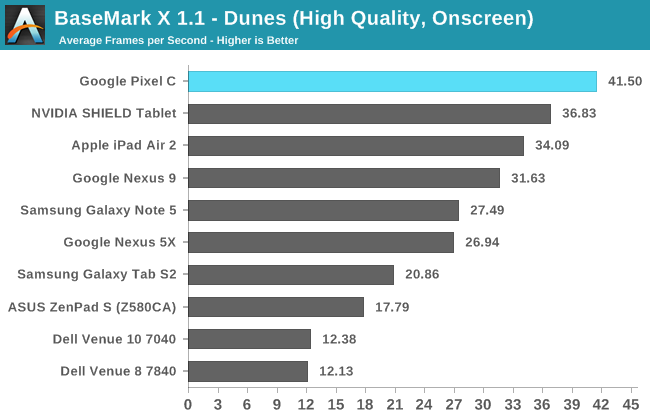
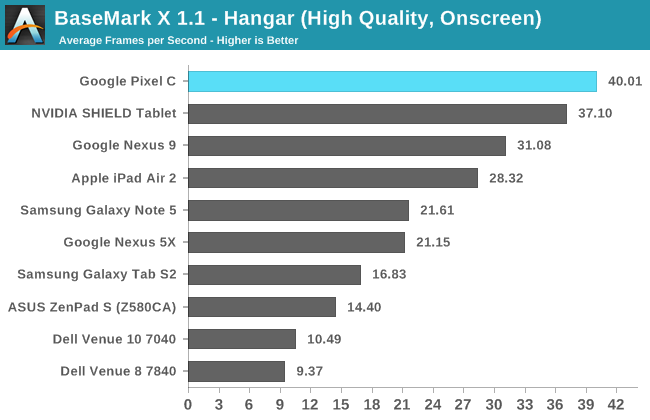
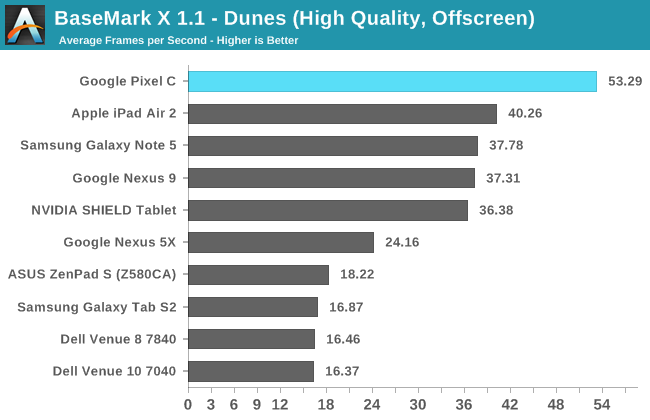

There's not a whole lot to be said about the Pixel C's performance in BaseMark X beyond saying that it's faster than any other Android device by a large margin. Even in the on screen tests, the Pixel C with its substantial resolution is still the fastest device on the charts. Absolute GPU performance as shown in the off screen tests shows a 43% performance improvement over the Tegra K1 used in the Nexus 9.
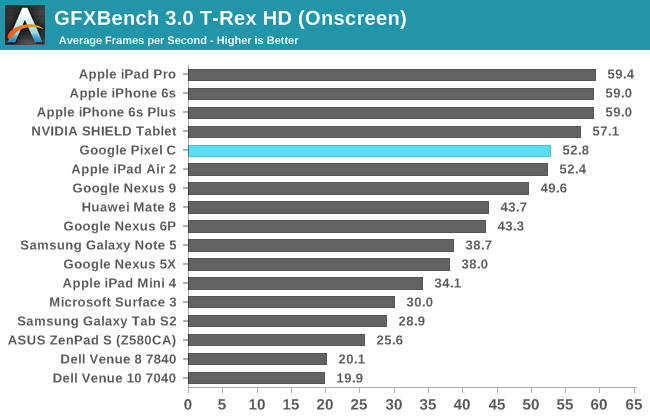
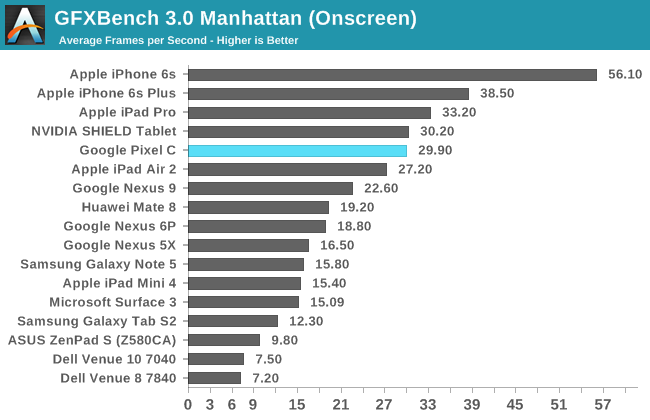
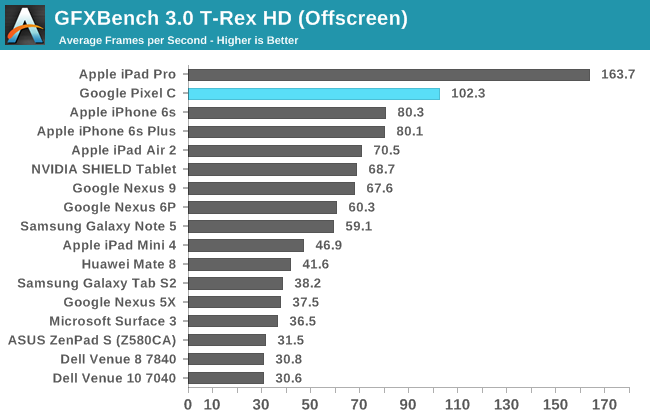
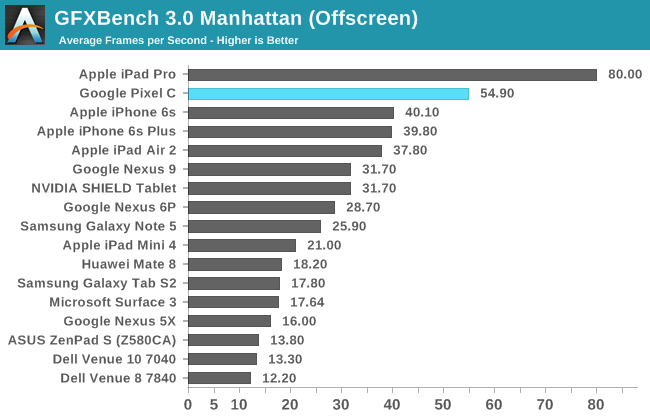
In GFXBench's T-Rex on screen test the Pixel C comes very close to hitting the Vsync limit despite its relatively high resolution. Off screen performance in both T-Rex and Manhattan is exceptional, and both tests make it clear that the Pixel C has the most powerful GPU in any mobile Android device. The gap between it and the next fastest device is quite large too, and the only tablet that can beat it is the iPad Pro with its A9X SoC.
The GPU performance of the Pixel C is unparalleled in the Android space. Not only that, but it ends up being faster than any similarly sized tablet, including the iPad Air 2 and of course the Nexus 9. It’s certainly impressive, and while I don’t mean to take away from the achievement, I can’t help but wishing that we had seen Tegra X1 come to market a bit sooner. Beating out A8X and Tegra K1 is great, but the former of those SoCs is also now well over one year old. While comparing to the iPad Pro is unfair in some respects due to the size difference, both devices do sell themselves as tablets priced for productivity, both launched at around the same, and NVIDIA’s GPU isn't as fast as the one in A9X. That being said, at $799 the iPad Pro is also significantly more expensive than the Pixel C, and relative to its price the Pixel C offers amazing GPU performance. The only concern would be if A9X shows up in some sort of regular sized iPad priced at the same level as the Pixel C. While I certainly do wish we could have seen Tegra X1 in some sort of tablet a bit earlier in the year, right now it does stand as the chip with the fastest GPU to ship in a standard size tablet, and I don’t think it will disappoint even when playing the most intensive 3D games.
Storage Performance
Something that hasn't been investigated very thoroughly in the past is smartphone storage performance. However, among high end devices this is now becoming a point of differentiation. Apple has moved to their own storage solutions that use NVMe and run over PCIe, while Samsung is pushing forward with UFS 2.0. While the Pixel C is a premium tablet, it ships with a standard eMMC storage solution. It also has Google's disk encryption enabled, which has been shown to impact storage performance in the past.
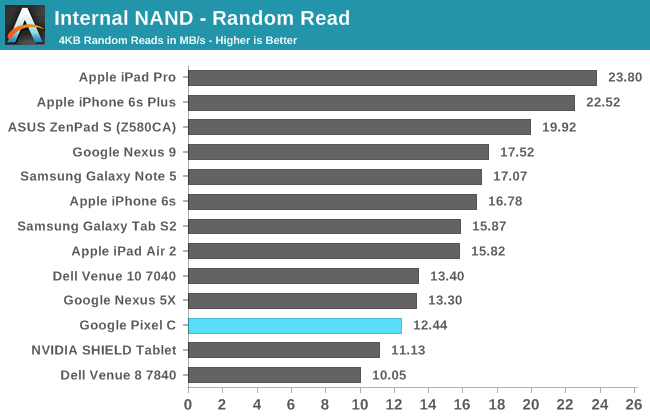

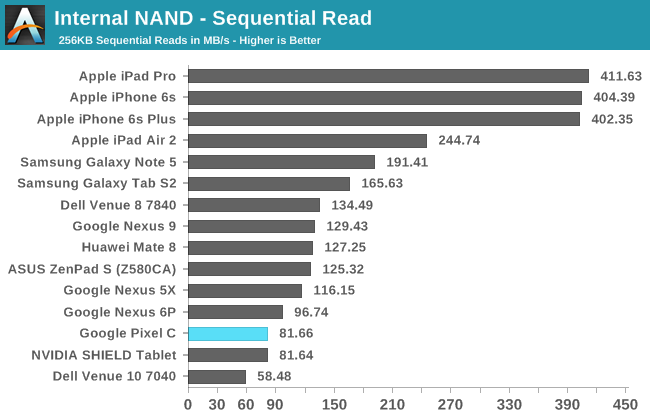
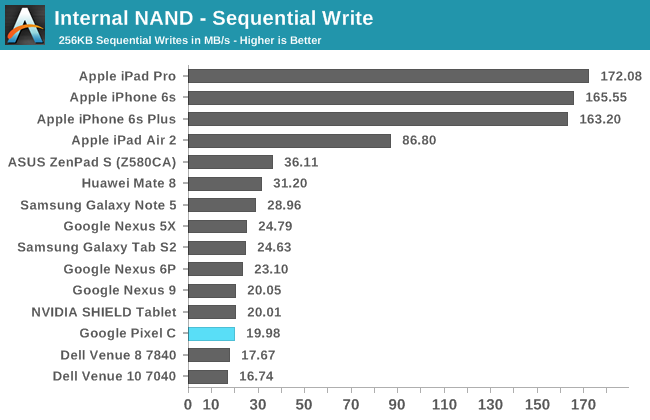
Like every Android device that Google has been involved in developing, the Pixel C doesn't fare well with our storage performance tests. Random reads and writes decent, although not competitive with new storage solutions like the SSD in the iPhone 6s and iPad Pro. Sequential speeds are simply not good at all, and definitely not competitive with what you'll get in an Apple device from the past two years or anything with an unencumbered and halfway decent eMMC or UFS storage solution. There's not much point in going over this issue again, because at this point it's clear that Google doesn't consider storage performance to be a metric worth competing on. I think it is, and I think that users end up appreciating the benefits of faster storage through quicker app installations, less loading when working with large files, among other benefits, even if they don't know what's driving those improvements behind the scenes. It's definitely something to think about when considering the Pixel C as a tablet, especially if you have a productivity focus.










122 Comments
View All Comments
testbug00 - Tuesday, January 26, 2016 - link
Turns them off right at boot.Kepe - Monday, January 25, 2016 - link
Oh man, I've been looking for a new (Android) tablet for a while now to replace my HP Touchpad from 2012 (running Marshmallow, btw). I haven't found a single device that has a decent, modern SOC, resolution of 1920x1080 or higher and a decent price tag.Google really needs to step its game up if it wants to stay relevant in the tablet market. Android needs better tablet features and apps that take advantage of the screen real estate. Device manufacturers clearly aren't very interested in making decent Android tablets at the moment, and app developers aren't very interested in making their apps tablet-friendly.
thestryker - Monday, January 25, 2016 - link
I was in much the same boat as I really don't see the point in smaller tablets... I have a phone with a 5" screen, if I'm reaching for a different device it had better offer some screen real estate. I ended up stumbling across the LG G PAD II 10.1 (V940N) and was shocked that nobody seemed to be talking about it at all, including LG who makes it.It's definitely not the fastest available, but it cost $300 (I got one as soon as I found a retailer with it) for a 1920x1200 display, Snapdragon 800 (MSM8974), 2GB RAM and 16GB storage. The build quality is rather sturdy for something that inexpensive, battery life is solid and I really haven't had any issues with it. LG's software isn't very intrusive, and they have a very good multitasking setup (though quite limited in what it works with) that has worked very well the few times I've used it.
This type of device is exactly what I wish was talked about more, because I feel like that's the sweet spot which can be available with google via android. Things like this definitely aren't on the radar for tech news, and obviously not even the companies who make them unfortunately.
5th element - Monday, January 25, 2016 - link
I'm in the same boat, I'm still on a nexus 7 2013 and want a worthy replacement. It seems like a good SoC with a great screen in wide-screen is hard to come by 😑deppman - Friday, January 29, 2016 - link
The Shield tablet is already far superior to the Nexus 7 2013 in almost every respect, with 2-4x with performance in some cases, runs Android 6 and has neat Nvidia extras like gforce now, mini hdmi out, and a very usable sdcard. Check out how it performs in these charts. And its $199.The rumored upcoming x1 version (March?) should be even more capable, but that is still just a rumor.
Teknobug - Monday, January 25, 2016 - link
ugh no thankszeeBomb - Monday, January 25, 2016 - link
Don't to need to even read... This is disappointing!Pjotr - Monday, January 25, 2016 - link
And how hard is it to start selling the Pixel C in Sweden and the other Nordic countries!? I don't want the keyboard, just a Google tablet. I can't order Nexus 9 anymore, it's been discontinued... so Google has no tablet on offer!deppman - Friday, January 29, 2016 - link
When you go to the play store, click on "view all tablets" and you should find the nexus 9 there.I own one, and it is sublime: an excellent display, fast, sturdy, and very comfortable to hold. I much prefer the soft-touch back to my all-metal tablet (a tf701t). You can get one there or from many retailers for less than an iPad mini.
If you wish to play games though, the best tablet IMO is still the shield tablet.
thelongdivider - Monday, January 25, 2016 - link
I don't understand why android manufacturers don't focus more on storage. One of the biggest revolutions for me in the computer space was going from a HDD to an SSD, and yet android continues to use some of the lowest quality flash they can find. Responsiveness won't improve by going from 4 to 8 cores and using the same terrible flash...